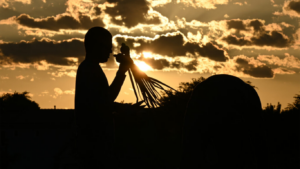Arizona is a state best known for its bustling housing markets, colleges, sports teams and warm weather. It is home to an estimated population of more than 7 million people who walk its streets, drive its roads, and enjoy its nightlife every single day.
Yet hidden beneath the veneer of this thriving city lies a hidden underbelly of crime. Women and children are being prostituted. Undocumented migrants and Native American children are disappearing and are left unreported. Human trafficking, appearing most often in the form of forced sex work, has taken root in heart this sunlight laden desert.
“Arizona has many trafficking networks that run through the state,” said Kathleen Winn, Executive Director of Project 25, an organization dedicated to ending sexual exploitation by 2025, and its Valley Against Sex Trafficking (VAST) program. “Is trafficking happening in Arizona? Absolutely.”
READ ALSO: Suns open learning center for sex trafficking victims
READ ALSO: Sex trafficking in Indian Country called ‘significant problem’
Winn, a long-time Arizona organizer, has an extensive history dealing with this elusive crime. She was the Community Outreach Director at the Arizona Attorney’s General Office from 2010 to 2015, and worked very closely with the issue of human trafficking through both litigation and advocacy. Through her work in VAST she has met with business leaders, survivors, law enforcement, and legislators to try to find a solution to sex trafficking and human trafficking within the state.

“We have criminal enterprises here,” said Winn. “That is happening in Arizona. That’s not anecdotal. Law enforcement, if asked, will tell you that is happening.”
There are several factors that drive human trafficking and sex trafficking in Arizona. The most important seems to be its geographic location and tourism industry. The crime is transient, and tends to show up wherever there are a lot of people moving between states or national borders.
Arizona bordering several states and Mexico, hosting spring training, having an abundance of young families, college students and foster care children, airports and military bases, and being a mixture of both Native American and American territories are all factors that play into the persistence of sex trafficking and human trafficking within it’s territory.
“So if you start to add all those up, no one of those is the reason, but all of them together are the reason,” said Winn.
Underground trafficking and prostitution rings are, by nature, elusive and well-funded. Motivated by greed and made nearly invisible through access to some of the best technology out there, they require dedicated resources and teams to deal with. Finding people who have been abducted or pushed into prostituion requires resources, civilian aid and technology. Maybe even a little bit of luck. Even more so in the digital age.
Moreover, the persistent danger associated with sex trafficking only makes the situation more complex. Chris Bray, a retired police sergeant for the Phoenix police department, served from 1979 to 2013. For the last 15 years of his career he served as an investigative supervisor for the VICE enforcement unit in the heart of Arizona. His job was dealing with human trafficking, prostitution, money laundering, illegal enterprises and gambling. During this time, he saw a lot of people hurt and killed going up against the human trafficking and prostitution industries.
“The 15 years that I was working these cases, we had, I believe, 16 Phoenix police officers killed in the line of duty,” said Bray. “In that same time period about 65 prostituted women, children, and one man were killed. So it is very dangerous.”
Most experts agree the defining factor in these sexually exploitative relationships is control. Convincing someone that they need your protection or that their life will be worse is a basic tactic used by these predators. Blackmailing the victim using sexually explicit photographs, video, or conversations is often step one in the development of these relationships. Step two, should emotional coercion fail, is physical violence.
“Some of the beatings these victims endure is absolutely horrific. When you sit across the table from a victim, and you are looking at the bruises on this person, and you see that these bruises are in various stages of healing. That tells you this person was getting assaulted, beaten, and injured multiple times a week. Sometimes a day,” said Bray. “It will turn violent, eventually, just as a means of control.”

Human trafficking and sex trafficking are evolving crimes. Crimes that the internet has played a huge role in promoting. While the typical image of an abduction is that of a white van stopping on the road and throwing someone inside it, the truth is many of these relationships are actually formed through online interactions and what experts call grooming.
“It’s amazing to me how uninformed people are,” says Brenda Gifford, founder of the Arizona Run Against Trafficking, an anti-trafficking event. “What 12-year-old girl doesn’t want to be 20? What girl doesn’t want to be Beyonce? They want it. They want to have the gear. They want to have all of the bling. They want to have all of the stuff. They want to be told that they are mature, and they’re smart, and they’re pretty. Because most kids are not getting that at home.”
“It’s a dip your toe in it sort of thing. The old photographer ploy, where I am a talent scout and I think you’ve got what it takes, and so for the next several hours I am going to get you incrementally into doing a modeling shoot for me… They are selling the false dream. They are appealing to their desire for money, for vanity, and they are going to incrementally take them to a point where they are okay with exposing themselves,” Bray said.
From that point forward the victims, often young, find themselves in an ever-perpetuating nightmare.
“That naked selfie gives me control over you because I now have a lever to use against you. How would you feel if this selfie started showing up in school? What if I sent it to your parents? What if I posted it near your church? Well do what I say and that won’t happen to you… It’s so simple it’s almost formulaic,” Bray explained.
Something else that’s shaping the face of sex trafficking, according to both Winn and Bray, is a culture that pushes children into sexual promiscuity from earlier and earlier ages.
“Is government failing us?… I would say it is bigger than that,” said Winn.” You have an acceptance right now of hyper-sexualized content; of education materials that are probably age-inappropriate. So yes, government’s politics are failing, but I think we also have to be responsible for the decisions we as consumers make. And if we as a consumer are consuming porn and inappropriate content and going to massage parlors to get sex acts preformed on us, then we are culpable and liable too. We can’t lay that at the feet of politicians.”
Winn says this cultural drive towards promiscuity clashes in a bad way with human trafficking. Her theory is that an increased exposure to sexual content through media increases the demand for sex by the general public. This increased demand for sex increases the market for prostitution and human trafficking to supply prostitution rings. Moreover, online pornography, a multi-billion dollar-a-year industry, continues to provide easy access for children and a bustling market for predators.
“If we continue to buy these services and participate then we are just as guilty. You know, look at cancel culture. We have done a really good job this last year of not liking certain things depending who was saying that they liked it or didn’t like it,” said Winn. “Wouldn’t it be great if we all agreed to cancel pornography and rape-for-profit businesses when we discover them by making… the penalties far more stringent than they are right now.”
In the fray between Arizona police forces and other anti-trafficking organizations, Winn’s VAST and Project 25 have made major leaps within the state in spreading awareness of the issues, shutting down dangerous sex-trade markets, and rescuing trafficking victims. Previously a part of legislation that shut down sex-markets cultivating on the classified ads publisher Backpages, Winn has continued to set her sights higher and higher in the fight against sexual exploitation.
Most recently, work done through Winn’s organization within the heart of Phoenix has led to the rescue of several children. While the details of these events cannot be published in order to protect the mechanisms involved, progress is being made. New methods of fighting human trafficking have been developed. New players, wielding new tools, have entered the fight.




